|
Posted 7/25/22
MASSACRES, IN SLOW-MO
Poor Chicagoans complain that their massacre never ends
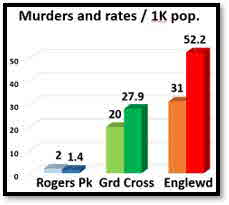
For Police Issues by Julius (Jay) Wachtel. Here’s what a middle-aged resident of Chicago’s Grand Crossing area recently had to say about violence in his neighborhood:
We’re ignored here. Kids get shot here — they throw them in the bag and keep on going. But they got the whole SWAT team out there in Highland Park trying to get the bottom of this sh--.
“J.R.” was referring to the full-bore police response, including cops from Chicago, to the recent Fourth of July massacre, when a troubled youth armed with an assault rifle opened fire during a parade in nearby Highland Park, gunning down seven spectators and wounding more than two-dozen. Situated twenty-seven miles north of Chicago, the prosperous small city (pop. about 30,000) boasts a median household income of $147,067. That’s more than twice Chicago’s $62,097 and a full five five times Grand Crossing’s abysmal $30,110.
He wasn’t the only Chicagoan to feel aggrieved. In crime-stricken Englewood (median income $22,228), a neighborhood’s self-described “Big Mama” despaired of a solution. “They have a lot of resources there in Highland Park. Our babies see people get shot while they’re at a playground, and there’s no counseling. They have to suck it up and deal with it.” She was referring to the recent gunning down of a man by a nearby playground. And, not long before that, to the young man who ran into her yard, bleeding profusely from a gunshot wound.
Click here for the complete collection of strategy and tactics essays
A post-massacre, in-depth Chicago Tribune piece about Highland Park mentioned the city’s affluence. And, as well, a resident’s annoyance that it mattered:
‘Affluent’ has all sorts of meanings. Besides, who cares how rich people are if they’re being shot at? They’re people. It suggests we’re protected from the world. Plus, we’re not fancy! There are little, teeny homes here, too!
There was also blowback after the piece was published. One letter-writer complained that “it’s not the time (if ever there is one) to talk about the haves and have-nots of a community still reeling from the horrific events of July Fourth.”
Indeed, the mayhem that took place within the span of a few moments has left a scar on Highland Park and its citizens that may never heal. We’re certain that neither “J.R.” nor “Big Mama” harbor ill will against the distraught community. But they are clearly frustrated with the perceived official neglect – and the all-too-visible consequences of that neglect – that they and their neighbors supposedly endure day-in and day-out because of poverty.
We’ve never felt that poverty “causes” crime and violence. But it’s definitely associated with the factors that do. Over the last decade-plus, essays in our “Neighborhoods” special topic have probed this connection. Invariably, we’ve found that crime, violence and economic conditions are tightly linked. In “The Usual Victims” we compared 2019 and 2020 murder rates for Chicago, Los Angeles and New York City, and, within each, between one low-poverty and one high-poverty neighborhood. As one might expect, Chicago’s notorious Englewood area, where 46 percent were poor, endured a murder rate seventeen times that of relatively benign Rogers Park, where “only” 26 percent of residents were poor.
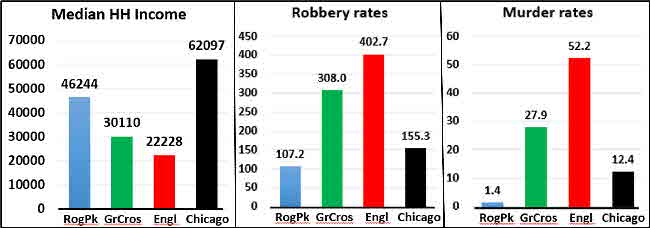 |
 |
That disparity has persisted. Check out these charts, which depict 2022 data for Rogers Park (blue), Grand Crossing (green), Englewood (red), and Chicago overall (black). Median household income for each neighborhood is from a recent Chicago planning report. Robbery and murder rates (per 100,000 pop.) reflect offenses committed between January 1 and July 10, 2022 and were computed using CPD crime data and district populations in a Chicago IG report.
It’s the same old story: lower incomes, higher rates of violent crime. Check out our lead graph. Grand Crossing’s (J.R.’s area) raw murder count, 20, is a stunning ten times that of Rogers Park, which has nearly twice the population but suffered “only” two criminal homicides. Grand Crossing’s murder rate is twenty times that of Rogers Park and more than twice Chicago’s overall. And look at those robbery numbers! It’s not surprising that some citizens of Grand Crossing wonder where all that help went.
So what about that “help”? Here the situation’s less clear. We downloaded 2017 Chicago police division staffing data from the Citizens Police Data Project, 2017-2020 stop data from the Chicago I.G., and 2022 arrest data (thru July 10) from the CPD statistics portal. Each rate was calculated per 1,000 residents of the corresponding police district.
Deployment isn’t simply a matter of population size. Officer strength reflects differences in district crime rates. Although District 7’s (Englewood) population is less than half District 24’s (Rogers Park), it reportedly had more than twice as many cops. And as one would expect, more cops means lots more stops and arrests. Englewood officers cumulatively made about four times as many stops as their colleagues in Rogers Park and 1.6 times as many arrests.
Chicago’s cops have a substantially greater presence and act far more proactively in crime-beset neighborhoods. Their efforts seem a version of the “Geographically Focused” and “Hot Spots” strategies that NIJ and academic researchers (e.g., “Hot-spots policing and crime reduction”) have repeatedly praised. As we mentioned in “Driven to Fail,” these approaches have tamped down violent misbehavior in many places.
Bottom line: CPD is not ignoring crime-stricken neighborhoods. Yet considering the violence that residents of places like Grand Crossing and Englewood endure, their irritation is easy to understand. What to do? Maybe particularly beset areas could use more cops. Or maybe we could get the ones already there to “crank things up.”
Clearly, either approach could pose big problems. Englewood and Grand Crossing already enjoy disproportionate numbers of cops. Pulling officers from other areas might easily lead to more crime in those districts. As for increased hiring, that may also be out of reach. Even if there’s money for salaries, suitable candidates are proving hard to find. Cities across the U.S. have been losing officers, and Chicago’s numbers are presently “the lowest in recent history”. About 350 of its cops retired in 2018, and nearly twice that number – more than 660 – retired in 2021.
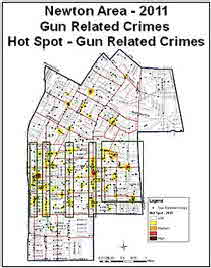 What about increasing the productivity of officers already on the job? Consider “LASER,” LAPD’s 2009 hot-spots incarnation. A product of its “Smart Policing Initiative,” LASER targeted known offenders and graced high-crime areas with intensive patrol (“Driven to Fail”). And it seemed very effective. Problem is, high-crime areas tend to be poor and disproportionately populated by persons of color. Even if cops try to be careful, racial and ethnic disparities in stops, searches and arrests seem inevitable. Add in pressures to do more, and you’ve “A Recipe for Disaster”. By 2019 an accumulation of frustration over the allegedly abusive treatment of Black citizens in LASER areas led a “shouting, overflow crowd of about 100 protesters flaunting ‘LASER KILLS’ signs” – the very residents of the community cops were supposedly trying to help – to demand the program end. What about increasing the productivity of officers already on the job? Consider “LASER,” LAPD’s 2009 hot-spots incarnation. A product of its “Smart Policing Initiative,” LASER targeted known offenders and graced high-crime areas with intensive patrol (“Driven to Fail”). And it seemed very effective. Problem is, high-crime areas tend to be poor and disproportionately populated by persons of color. Even if cops try to be careful, racial and ethnic disparities in stops, searches and arrests seem inevitable. Add in pressures to do more, and you’ve “A Recipe for Disaster”. By 2019 an accumulation of frustration over the allegedly abusive treatment of Black citizens in LASER areas led a “shouting, overflow crowd of about 100 protesters flaunting ‘LASER KILLS’ signs” – the very residents of the community cops were supposedly trying to help – to demand the program end.
Lower-income Chicagoans aren’t the only Americans who feel frustrated over their perceived abandonment by city hall. Let’s dial it back three years. Here’s what a resident of a poor, violence-plagued Baltimore neighborhood had to say about her visit to a “well-off area”:
The lighting was so bright. People had scooters. They had bikes. They had babies in strollers. And I said: ‘What city is this? This is not Baltimore City.’ Because if you go up to Martin Luther King Boulevard we’re all bolted in our homes, we’re locked down. All any of us want is equal protection.
But how did Baltimore’s policing get “unequal”? In April 2015, Freddie Gray, a 25-year old Baltimore resident with a criminal record, ran from officers performing enhanced patrol in a poor, crime-ridden area. He was caught, arrested for carrying a switchblade, and placed in a police transport van. Handcuffed but otherwise unsecured, Mr. Gray tumbled in the van during his careless transport and was fatally injured. State prosecutors filed (ultimately, unsuccessful) charges against the six cops involved, and DOJ opened an inquiry into the agency’s practices (click here for the findings).
Reacting to their slapdown, Baltimore cops staged a prolonged “slowdown”. They sharply curtailed self-initiated activity, and stops of suspicious cars and pedestrians plunged. As the (interim) Chief described it, “in all candor, officers are not as aggressive as they once were…” And yes, there were consequences. As our tables in “Police Slowdowns” illustrate, Baltimore killings skyrocketed, and stayed high.
As the last decade came to an end, negative public reaction to alleged racial profiling and police abuse (e.g., the killing of George Floyd) led agencies throughout the U.S. to dial things back. Then, perfectly timed, came the pandemic. Unrestrained by aggressive strategies such as hot-spots, crime and violence 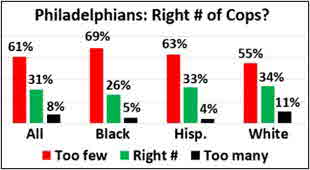 soared. So did concerns about personal safety. According to a recent Pew poll “70% of Philadelphians see crime, drugs, and public safety as the most important issue facing the city—up nearly 30 percentage points from 2020”. At 44%, the proportion who reported feeling safe in their neighborhoods is the lowest since 2009. And although only 32 percent of Blacks believe that police treat them equally, a full sixty-nine percent (the largest proportion by race) feel there are too few cops. soared. So did concerns about personal safety. According to a recent Pew poll “70% of Philadelphians see crime, drugs, and public safety as the most important issue facing the city—up nearly 30 percentage points from 2020”. At 44%, the proportion who reported feeling safe in their neighborhoods is the lowest since 2009. And although only 32 percent of Blacks believe that police treat them equally, a full sixty-nine percent (the largest proportion by race) feel there are too few cops.
Well, more cops may be out of reach. But in reaction to what seems our “new normal,” three major burg’s: Los Angeles, New York City and Chicago brought back hot-spots policing. For a closer look at Chicago’s approach check out its District Strategic Plans (click here for District 3, here for District 7, and here for District 24). Each sets out priority locations and details the manner of intervention. For example, here is the “enforcement response” for an area identified as “Howard Street, between Greenview and Clark” in relatively benign District 24 (Rogers Park):
Focus enforcement efforts and missions on Howard Street where gang members are known to loiter; drink on the public way, and sell narcotics. Conduct gang and narcotics dispersals and issue ANOV’s (our note: citations), while creating a greater sense of safety on Howard Street.
Be sure to check out our homepage and sign up for our newsletter
In dangerous District 7 (Englewood), where “opposing gang factions are in conflict with each other to expand their territories” and shootings frequently happen, problem areas get special resources. Here is one example:
Conduct missions with Beat and Tactical cars to resolve conflicts. POD (our note: fixed observation cameras) https://home.chicagopolice.org/inside-cpd/police-observation-device-pod-cameras/ and traffic missions to assist in those efforts. Community Safety Team (CST) to assist with enforcement. District Intelligence Officers (DIO’s) will continue to gather intelligence on gang factions & claimed territories.
We’re quite confident that Chicago is not ignoring its most imperiled citizens. High-crime districts get lots of extra help. Problem is, the frequent episodes of violence endemic to these areas tie up squads of officers for prolonged periods. Trying to maintain adequate patrol coverage by stuffing beset precincts with extra troops has its limits.
So what’s left? That takes us back to the dilemma that pervades our “Neighborhoods” posts: cops can’t correct what most needs fixing! So what can? Let’s self-plagiarize from “Fix Those Neighborhoods!”:
Yet no matter how well it’s done, policing is clearly not the ultimate solution. Preventing violence is a task for society. As we’ve repeatedly pitched, a concerted effort to provide poverty-stricken individuals and families with child care, tutoring, educational opportunities, language skills, job training, summer jobs, apprenticeships, health services and – yes – adequate housing could yield vast benefits.
We’ll untangle another problem in a couple of weeks. Stay tuned!
UPDATES (scroll)
6/13/25 An in-depth investigation by The Trace revealed that Chicago’s homicide clearance rates are significantly lower when victims are Black. That finding comes on the heels of a major revamp of Chicago P.D.’s homicide investigation process, which implemented recommendations made by reviewers from the Police Executive Research Forum. Changes included increasing the number of specialized homicide detectives and adjusting their caseload to enable them to pursue long-term investigations. Technology was also upgraded. But reformers point out that residents of the city’s poorer areas continue to be deeply distrustful of the police. They are less likely to cooperate with detectives, which inevitably affects what crimes get solved.
6/2/25 It was about two a.m. on Saturday, May 31st. As officers tried to break up a large gathering of teens in Chicago’s poverty and violence-stricken Auburn Gresham neighborhood, a car drove by and its occupants opened fire. Seven youths, ages 17-19, were wounded, apparently none critically. All were transported to hospitals. As of yet, there have been no arrests.
5/5/25 “Nearly 75% of gun violence takes place in just 20 of the 77 neighborhoods in Chicago.” Violence-reduction program Chicago Cred’s views seemed borne out by a series of links in the Chicago Tribune’s May 3rd. morning homepage to four woundings (at least two proved fatal) and a series of stabbings in four of the troubled city’s most poverty-stricken, violence-ridden neighborhoods: North Lawndale Chicago Lawn Austin Englewood Austin (again).
4/28/25 Five Chicago P.D. tactical officers opened fire on Dexter Reed when he shot one in the wrist during a March 2024 traffic stop. Reed, who was stopped for not wearing seat belts, was killed. While his shooting was deemed justified, the officers were among a group that was being investigated for repeatedly stopping motorists, including Reed, without sufficient cause. Four remain off duty; they face retraining and brief terms of suspension. The fifth quit. A draft version of CPD’s new traffic stop policy was recently released. (See 2/7/25 and 4/15/24 updates)
4/21/25 A late-evening shooting in the front yard of a Chicago residence wounded three teens, ages 17, 18 and 19, one critically. The shooter, with whom they reportedly had an argument, fled in an SUV. He has not yet been identified. It happened on April 18 in the city’s poverty-stricken Austin neighborhood (Zip 60644, pov. 29.7%).
3/17/25 An investigation by the Chicago Sun-Times reveals that only six percent of the city’s 2,300 non-fatal shootings in 2024 have (so far) led to an arrest. Its analysis suggests that assigning more detectives to investigate shootings would help. But although the mayor has promised to hire more cops, the number of detectives has grown fewer; those assigned to handle shootings plunged twenty percent between 2023 and 2024. It’s thought that the slim risk of getting caught - only one out of four Chicago murders is cleared by an arrest - has emboldened criminals and made violence worse.
3/4/25 Robert E. Crimo III pled guilty to committing the massacre at the July 4th., 2022 parade in Highland Park, Illinois, where he used an assault rifle to murder seven spectators and wound over two dozen. He will draw multiple consecutive life terms; it seems certain that he will never be released.
2/10/25 In March 2024 Chicago tactical officers pulled over a car driven by Dexter Reed. He opened fire and wounded an officer who approached. Reed was shot and killed in a hail of gunfire. But the reason for the stop is unclear. His survivors sued, and Chicago’s City Council is mulling over a proposed $1.25 million settlement. In a formal editorial, the Chicago Tribune strongly objects. “Surely, it’s possible to hold police accountable for wrongdoing or terrible mistakes while also supporting them when they act reasonably in the face of mortal danger...this case strikes us as about more than money. Sometimes a principled stand is in order.” (See 4/28/25 and 4/15/24 updates)
1/9/25 On December 31 Chicago Mayor Brandon Johnson and Police Supt. Larry Snelling credited “a whole of government approach” for bringing about a drop in violent crime. And particularly of murders, which were down in 2024 for the third year in a row. But eight homicides during the following six days, and the non-fatal wounding of twenty-eight Chicagoans, have clouded the new year’s prospects. And the violence is happening in the same besieged neighborhoods (e.g., North Lawndale) as always.
12/30/24 Chicago murders are down 7% citywide from 2023. But when comparing police districts, the numbers are admittedly “uneven.” While the normally violence-beset Harrison District has suffered substantially fewer killings, the afflicted Ogden District is enduring a sharp increase, from 34 murders thru mid-December 2023 to 48 this year. And two beats within the violence-racked Grand Crossing area are even worse off, going from 12 murders in 2023 to 25 this year. Some are assigning blame to the increased lethality brought on by full-auto switches, extended magazines and assault rifles.
7/22/24 Gunfire continues to beset Chicago youths. Four, ages 14 to 17, were wounded Saturday afternoon. Two were struck in the back while standing next to a South Chicago sidewalk. Less than an hour later, in the beset Grand Crossing neighborhood, two more were wounded by assailants who opened fire from a passing car. And during early Sunday morning, a 7-year old was wounded on the Dan Ryan Expressway when the car in which he was riding came under fire from the occupants of another vehicle. No arrests have yet been made in any of these incidents.
7/5/24 Suspects armed with a handgun and rifle jumped out of a car and opened fire on a home in Chicago’s poor, violence-beset Grand Crossing neighborhood. Two females, ages 42 and 22 were killed, and three children, ages 5, 7 and 8 were critically wounded. “Y’all don’t get no cool points for coming to shoot up a crib at six o’clock in the morning where nobody in the house gang affiliated, none of that,” said the older woman’s son, who was awakened by the gunfire but unhurt. A police commander suggested that the shooting stemmed from a “personal dispute.” No arrests have yet been made.
4/15/24 In Chicago’s violence-ridden New City neighborhood, shots fired from a passing car at a family gathered in its front yard to celebrate a confirmation killed a 9-year old girl and wounded three other children, two critically. Seven adults, ages 19 to 40, were also wounded. The homeowner, who was shot in the foot, said that gun violence had led his family, which had lived in the area more than thirty years, to seek a home elsewhere. “We were just a little too late.” No arrests have yet been made, and police said that gang violence was suspected.
Plainclothes-wearing police tactical officers in Chicago’s beset Humboldt Park area pulled over Dexter Reed on March 21 because he wasn’t belted. His windows were tinted, and he refused to roll them down. Reed then opened fire on the officer on the passenger side of the car, wounding him in the arm. Police responded with a barrage of 96 shots, and an officer reportedly kept shooting as Reed, fatally wounded, lay on the ground. COPA, the city’s civilian police overseer, criticized the stop and urged that the four officers involved (they’re under investigation for alleged past misdeeds) be suspended. At the time, Reed was pending charges for “aggravated unlawful use of a weapon.” COPA reports and videos (See 2/10/25 update)
Keep going...
|
Did you enjoy this post? Be sure to explore the homepage and topical index!
Home Top Permalink Print/Save Feedback
RELATED OP-ED
Memo to Joe Biden: Focus on Neighborhood Safety (The Crime Report, December 7, 2020)
RELATED POSTS
Neighborhoods special topic Stop-and-Frisk and Hot-Spots special topic
Punishment Isn’t a Cop’s Job (II) Worlds Apart...Not! The Usual Victims Let’s Stop Pretending
Full Stop Ahead A Recipe for Disaster Fix Those Neighborhoods! Mission Impossible?
Driven to Fail A Not-so-Magnificent Obsession Police Slowdowns (I) (II) A Very Rough Ride
Of Hot-Spots and Band-Aids
Posted 5/30/22
COPS V. ASSAULT WEAPONS:
A HOPELESS SITUATION
Even the speediest, most expert response may not suffice
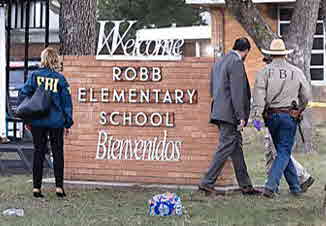
For Police Issues by Julius (Jay) Wachtel. On May 26, clicking on the “gunshop” link at Oasis Outback produced a static, full-screen display of “Our Hearts Are With the Families of Uvalde” in large block letters. To get to the intended destination page we had to manually type in its address. (Doing that worked. It also brought up a proud announcement that the store “Is Now a Class 3,” meaning it sells machineguns and silencers.)
Oasis’ redirection was certainly understandable. As the whole world knows, it’s the sporting goods store where eighteen-year old Salvador Ramos legally purchased the Daniel Defense, AR-15 style, .223 caliber semi-automatic rifle he used to murder nineteen students and two teachers at Robb Elementary School, which sits only three miles away. Ramos bought the gun on May 17. He went back the next day to get 375 rounds of ammunition, then returned two days later to buy a second assault rifle (he left it behind in his truck during the massacre.) And on May 24 it was time for a massacre!
Click here for the complete collection of strategy and tactics essays
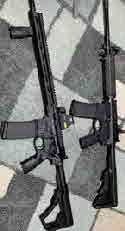 Ramos was proud of his lethal new toys. He posted photos of the weapons and of an ammunition magazine on his Instagram account. He also asked another user, whom he apparently picked at random, to repost the pictures on her account. But she refused. “What your guns gotta do with me?” she demanded. He messaged her again early the morning of the attack. “I’m about to...I got a lil secret I wanna tell u.” He promised to reveal it before 11:00 am. And he did, but not to her. Instead, he spilled the beans to a fifteen year-old FaceTime chum in Germany. Days earlier he bragged to her about acquiring bullets that “would expand when they struck somebody.” This time his first message was about a dispute with his grandmother. A few minutes later he texted “I just shot my grandma in her head.” And seconds after that, “Ima go shoot up a(n) elementary school rn (right now).” Ramos was proud of his lethal new toys. He posted photos of the weapons and of an ammunition magazine on his Instagram account. He also asked another user, whom he apparently picked at random, to repost the pictures on her account. But she refused. “What your guns gotta do with me?” she demanded. He messaged her again early the morning of the attack. “I’m about to...I got a lil secret I wanna tell u.” He promised to reveal it before 11:00 am. And he did, but not to her. Instead, he spilled the beans to a fifteen year-old FaceTime chum in Germany. Days earlier he bragged to her about acquiring bullets that “would expand when they struck somebody.” This time his first message was about a dispute with his grandmother. A few minutes later he texted “I just shot my grandma in her head.” And seconds after that, “Ima go shoot up a(n) elementary school rn (right now).”
Ramos was by most accounts a troubled soul. A former classmate – Ramos had sent him pictures of his newly-bought guns – said that their gaming sessions were frequently interrupted by calls from Ramos’ mother, who complained that he was “doing nothing with his life.” Ramos would reply with expletives. He frequently wound up at his grandmother’s house, which is where he was living when he bought the guns and embarked on his attack.
Ramos had recently dropped out of high school. He took a job at a fast-food joint but soon walked out on that as well. A former supervisor called him a loner. “You know how my guys talk to each other and are friendly? He wasn’t like that.” His German friend thought him friendless and isolated. Their exchanges occasionally proved disturbing. Such as when Ramos bragged that he “threw dead cats at people’s houses.”
Another virtual acquaintance said that Ramos once streamed an image of himself holding a gun. There was blood on the ground, which Ramos attributed to a nosebleed.
Ramos’ world seemed wholly virtual. Until it wasn’t. About 11:30 am on May 24, 2002, after shooting his grandmother – she was struck in the face and critically wounded – he put both rifles and a bag of ammunition in a pickup truck and drove to Robb Elementary School. According to Texas DPS Chie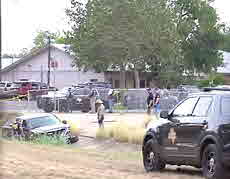 f Steven McCraw, Ramos crashed his vehicle into a ditch and exited with the Daniel Defense rifle and his ammo. After firing at two persons who were leaving a nearby funeral home he crouched behind a car and fired at a school building. A district police officer drove by but apparently didn’t see him. Ramos climbed a fence and entered the school through an open back door. As he reached classrooms 111 and 112 – they’re interconnected – he unleashed a barrage of “more than 100 rounds,” apparently firing through the walls. That, we assume, is how his victims met their horrendous fates. f Steven McCraw, Ramos crashed his vehicle into a ditch and exited with the Daniel Defense rifle and his ammo. After firing at two persons who were leaving a nearby funeral home he crouched behind a car and fired at a school building. A district police officer drove by but apparently didn’t see him. Ramos climbed a fence and entered the school through an open back door. As he reached classrooms 111 and 112 – they’re interconnected – he unleashed a barrage of “more than 100 rounds,” apparently firing through the walls. That, we assume, is how his victims met their horrendous fates.
Three local police officers entered the school “two minutes” behind Ramos. Four colleagues soon joined them. Ramos fired at them from the classrooms. Bullets pierced a wall and inflicted “grazing wounds” on two of his pursuers. Before long, nineteen officers had staked out the hallway. And that’s where the school district police chief told them to wait.
Police evacuated all the students they could. But the surviving occupants of rooms 111 and 112 remained under Ramos’ control. Within minutes, several surreptitiously dialed 9-1-1 and in hushed tones reported that many classmates had been shot dead. They begged for police to come in. Eventually, a tactical team was assembled. Using a ballistic shield for cover, an “elite Border Patrol tactical unit” and several local officers confronted Ramos. Gunfire broke out. Ramos was killed. Unfortunately, the shield didn’t offer perfect protection and an agent “was shot in the foot and grazed in the head.”
That entry happened about 12:50 pm. According to the ABC News timeline, that took place one hour and fifteen minutes after the first set of officers followed Ramos onto the campus.
This delay has occasioned a lot of criticism. According to Texas DPS Director Steven C. McCraw, “It was the wrong decision, period.” His sentiments were echoed by Texas Governor Greg Abbott, who declared himself “absolutely livid.” Even if Ramos  had stopped shooting at students, prompt medical attention could have allowed more of the injured to survive. Alas, it's not the first time that police have been accused of failing to speedily intervene during a school massacre. Only four years ago, in February, 2018, a 19-year old former student used an AR-15 style rifle to kill seventeen persons and wound an equal number at Marjorie Stoneman High School in Parkland, Florida. Nikolas Cruz then blended in and simply walked away. Deputies were severely criticized for not promptly going in, and the Sheriff was ordered removed. had stopped shooting at students, prompt medical attention could have allowed more of the injured to survive. Alas, it's not the first time that police have been accused of failing to speedily intervene during a school massacre. Only four years ago, in February, 2018, a 19-year old former student used an AR-15 style rifle to kill seventeen persons and wound an equal number at Marjorie Stoneman High School in Parkland, Florida. Nikolas Cruz then blended in and simply walked away. Deputies were severely criticized for not promptly going in, and the Sheriff was ordered removed.
Similar concerns were voiced after the 1999 Columbine massacre, when two Colorado high school seniors gunned down twelve students and a teacher and wounded twenty-three others. While all that happened within twelve minutes of the initial 9-1-1 call, SWAT didn’t go in for forty-five minutes. By then, both shooters had taken their own lives. In fact, Columbine is widely credited for leading to the development of the “Immediate Action/Rapid Deployment Approach.” This technique, which enables ordinary officers to quickly assemble into teams and confront active shooters in a variety of settings, has been adopted by police agencies throughout the U.S. massacre, when two Colorado high school seniors gunned down twelve students and a teacher and wounded twenty-three others. While all that happened within twelve minutes of the initial 9-1-1 call, SWAT didn’t go in for forty-five minutes. By then, both shooters had taken their own lives. In fact, Columbine is widely credited for leading to the development of the “Immediate Action/Rapid Deployment Approach.” This technique, which enables ordinary officers to quickly assemble into teams and confront active shooters in a variety of settings, has been adopted by police agencies throughout the U.S.
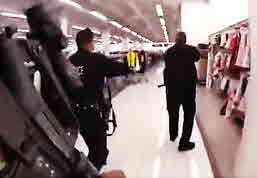 Rapid deployment has reportedly succeeded on many occasions. But we recently discussed an “immediate action” response in Los Angeles that turned out poorly (“Who’s in Charge?”). In December 2021 a 24-year old man on felony probation burst into a large clothing store and began assaulting customers and staff. LAPD dispatchers (incorrectly) informed officers that the suspect had fired shots. Responding officers quickly gathered, promptly assembled into a column formation, and got to work (see bodycam image). And when they neared the suspect, the officer on point opened fire with an assault rifle, fatally wounding a man whom he assumed was armed (he wasn’t.) Tragically, a police bullet also pierced an interior wall, killing a 14-year old girl who had taken refuge with her mother in a dressing room. Rapid deployment has reportedly succeeded on many occasions. But we recently discussed an “immediate action” response in Los Angeles that turned out poorly (“Who’s in Charge?”). In December 2021 a 24-year old man on felony probation burst into a large clothing store and began assaulting customers and staff. LAPD dispatchers (incorrectly) informed officers that the suspect had fired shots. Responding officers quickly gathered, promptly assembled into a column formation, and got to work (see bodycam image). And when they neared the suspect, the officer on point opened fire with an assault rifle, fatally wounding a man whom he assumed was armed (he wasn’t.) Tragically, a police bullet also pierced an interior wall, killing a 14-year old girl who had taken refuge with her mother in a dressing room.
Humans are unpredictable. Getting them to voluntarily comply can be difficult. Throw in the extreme lethality of firearms available to the general public and the challenge becomes enormous. As we’ve mentioned in past posts (see, for example, “An American Tragedy”) assault rifle projectiles sail through walls and ordinary ballistic garments as though these obstacles don’t exist. Should they strike flesh, the bullets indeed (as Ramos bragged) “expand,” creating huge cavities that pulverize blood vessels and destroy organs. It’s why the team that ultimately went in at Robb Elementary took that special shield.
We suspect that Ramos’ use of an assault rifle prompted the school police chief to adopt that “barricaded subject” approach. After all, Ramos’ bullets had already wounded two officers. To be sure, slowing things down so that responders can be adequately briefed and equipped (again, that shield) makes sense. It’s not only officer safety. After all, unless it’s exquisitely well-placed, police gunfire can easily endanger innocents. Again, think back to that L.A. clothing store.
But an hour? Once they realize they’re surrounded, “ordinary” criminals might simply give up. But individuals on a rampage – meaning school shooters and wackos who burst into clothing stores – are coming from a decidedly different mental place. In such cases, extending an ample opportunity to surrender can invite even more mayhem. On the other hand, hurried policing can, even if expertly delivered, prove tragically imprecise. Just ask LAPD.
No matter how well policing is done, it can’t prevent mass shootings. Neither can it always mitigate the outcomes. So what about doing something about the killers’ tools? We’ve repeatedly called for outright bans on assault rifles, which are essentially instruments of war (see, for example, “Ban the Damned Things!”). But even supposedly gun-unfriendly places like California have only managed to institute “pretend bans” that ignore what really counts: the weapons’ fearsome ballistics (click here and here for our articles on point in the Washington Post.)
Be sure to check out our homepage and sign up for our newsletter
What about background checks and “Red Flag” orders? Certainly, screening buyers can help. But reliable ways that consistently and reliably prohibit questionable characters from buying guns are simply out of reach. Ramos had his foibles, but they were nowhere near what a judge would require to bar him from buying guns. And in an awful coincidence, his first gun purchase came only three days after another murderous eighteen-year old – Payton Gendron – gunned down ten persons at the Tops market in Buffalo, New York. That mass murder, which also drew the world’s attention, was also done with an AR-15 style assault rifle that its mis-user legally bought. Gendron even had a seemingly substantial prior mental-health demerit. But it was never acted on, so he remained qualified to buy guns. And both sellers – Oasis Outback, Uvalde, TX; Vintage Firearms, Endicott, NY – reported that the transactions seemed perfectly routine.
Until, of course, they weren’t.
UPDATES (scroll)
8/14/24 Uvalde, Texas has just released a “massive trove” of audio and video recordings of the May 2022 massacre at Robb Elementary School. After viewing the bodycam videos, Dr. Johnny Nhan, a criminology professor and reserve cop, said that a lack of leadership and a “breakdown of communication” among the many agencies involved excessively delayed the response. According to Jesse Rizzo, whose niece was one of the victims, the videos showed that responders were “not afraid of the shooter. They're afraid of the weapon."
6/28/24 A Texas grand jury indicted former Uvalde school police chief Pete Arredondo on ten counts of felony child endangerment for “intentionally, knowingly, recklessly, and with criminal negligence” endangering the lives of ten minors during the school shooting perpetrated by Salvador Ramos on May 24, 2022. Arredondo was faulted for his failure to follow existing protocols for active shooter incidents. Former school police officer Adrian Gonzales was also charged. Both were booked and released.
5/28/24 Families of the victims of the massacre at Robb elementary in Uvalde, TX have sued Daniel Defense, which manufactures the AR-15 style rifle used by Salvador Ramos, for using online platforms including Instagram “to extol the illegal, murderous use of its weapons.” That lawsuit was filed in Texas. Another, just filed in California, accuses Activision Blizzard, maker of video game “Call of Duty”, to which Ramos was reportedly addicted, for “depicting and venerating the thrill of combat.” A third lawsuit, which seeks $27 billion from Uvalde and various law enforcement agencies, was filed last year.
3/13/24 After 25 years on the job, Uvalde Police Chief Daniel Rodriguez resigned. He escaped direct blame for the loss of life at Robb Elementary, as he was in Phoenix when the massacre took place and had left a subordinate in charge. Chief Rodriguez’s resignation came only a few days after the city’s release of a report that has been highly criticized for absolving Uvalde’s officers of blame. But city leaders praised Chief Rodriguez and wished him well.
3/8/24 According to a comprehensive report by the City of Uvalde, police Lt. Javier Martinez and Sgt. Eduardo Canales promptly went after the Robb Elementary school shooter. But Salvador Ramos had ensconced in a classroom and was unleashing barrages through its door. They couldn’t see him, thus couldn’t return fire because it might strike students. Ramos was armed with an AR-15, and there were no shields or body armor on site that could defeat its highly penetrating rounds.
1/19/24 DOJ released a comprehensive assessment of the law enforcement response to the May 24, 2022 mass shooting at Robb Elementary School in Uvalde, Texas. It praises the initial response, in which five of the first officers on scene “continued to press down the hallway and toward a barrage of gunfire erupting inside of rooms 111/112.” But it severely criticizes the abandonment of an aggressive response and the adoption of a prolonged, hour-long “barricaded subject” approach because two of the five officers suffered "graze wounds from shrapnel". Full Report
5/25/23 Trial is set to begin on May 31 for a fired Sheriff’s deputy who responded to the 2018 massacre at Marjorie Stoneman Douglas high school in Parkland, Florida. Scot Peterson, 60, is charged with multiple counts of child neglect and culpable negligence for failing to enter the school and confront Nikolas Cruz as he shot multiple students on the third floor. Peterson, who took cover outside the building, claims that he didn’t go in because he thought the gunfire was originating from elsewhere.
5/23/23 One year after the Robb Elementary School massacre in Uvalde, Texas, a State grand jury inquiry into the police response continues. The school police chief was fired, and five officers employed by various agencies were fired or quit. But DPS Chief Steve McCraw, who had ninety officers on scene, refuses to resign. Meanwhile Gov. Greg Abbott continues to turn away requests to tighten gun laws, as he did after the mass shootings in Sutherland Springs in 2017 and the El Paso Walmart in 2018.
5/22/23 Two weeks after the March 27th. Nashville massacre, Tennessee’s governor signed a law that further limits lawsuits against the firearms industry. According to the bill’s sponsor, its purpose “is just to try to help businesses in this state.” Still, some “high profile” shootings have led to settlements. For example, the $73 million paid by Remington to the families of the Sandy Hook victims. Meanwhile in Texas, families of the Uvalde victims are pressing on with their lawsuit against gun manufacturer Daniel Defense over its allegedly risky marketing practices.
5/9/23 A bill to raise the minimum purchase age for semi-automatic rifles from 18 to 21 reportedly has “no chance” to be enacted in Texas. But in the wake of the mass shooting in Allen, it was nonetheless moved along from committee with votes from House “Reds”. Allen’s shooter, though, was in his thirties, so the bill actually relates to Uvalde, whose gunman bought an AR-15 type rifle when he turned eighteen.
3/30/23 When interviewed after the Uvalde massacre, responding officers agreed that they didn’t storm the shooter because he had an AR-15 rifle, whose powerful projectiles made their regular ballistics vests useless. Two of their colleagues had already been grazed by rounds. “There was no way of going in,” said a sergeant. “We had no choice but to wait and try to get something that had better coverage where we could actually stand up to him.” A major legislative report made no mention of the officers’ remarks.
3/29/23 Audrey Hale, the 28-year old Nashville resident who staged a massacre at a Christian elementary school two days ago, was receiving medical care for an “emotional disorder.” Hale legally purchased the three guns used in the shooting, and four others, at local stores. All the guns were kept hidden from Hale’s parents, with whom Hale resided.
3/28/23 Yesterday morning 28-year old Audrey Hale entered Covenant School, a Christian
elementary school in Nashville, carrying two assault rifles and a pistol. Hale promptly opened fire, killing three nine-year
old students and three employees, each in their early sixties. Officers soon arrived and shot Hale dead. According to police,
Hale, once a student at the school, had no criminal record and two of the weapons were legally acquired from local sources.
More guns, plans for the massacre and a “manifesto” suggesting Hale’s motives were found in the residence
where Hale and Hale’s father resided.
3/17/23 Cullman, Ala. is home to West Elementary School. And it’s now home to bulletproof fold-out 8 X 8 rooms that can protect up to thirty persons from deranged shooters. Designed and installed by a local contractor, they were inspired by a plea from his wife as she watched coverage of the Uvalde massacre. Their ballistic protection is said to protect occupants from “most handguns and rifles,” and their locks are supposedly impermeable. Each costs about $50,000, and there’s hope for funding.
2/20/23 A profusion of inaccurate leads, including false reports of gunfire at multiple locations, and the mystifying complexities of a university campus with 400 buildings greatly complicated the response to the February 13 massacre at Michigan State University. Anthony McRae, the 43-year old man who opened fire in the Student Union and a nearby building, killing three students and wounding five, was later found off campus, dead from a self-inflicted gunshot wound.
12/3/22 Families of Uvalde school massacre victims have filed legal actions against school and state and local law enforcement authorities claiming $27 billion in damages for failing to properly follow mass shooting protocols and promptly confront the gunman. Daniel Defense, the manufacturer of the shooter’s gun, and the store where he bought it are being separately sued for $6 billion. While two officers have been fired and others resigned, the State’s public safety director insists that his officers “did not fail” the public.
11/18/22 Uvalde police Lt. Mariano Pargas, Jr. was the city’s acting police chief when the school massacre took place. He was also one of the first responders. Like the school police chief, he’s been severely criticized for the delay in confronting the assailant. And like the school police chief, he has consistently denied having been in charge of the response. Facing a bleak future, Lt. Pargas just resigned his cop job. But he remains a county commissioner, a position to which he was recently re-elected.
10/28/22 Orlando Harris, the 19-year old who stormed his old St. Louis high school with an AR-15 style rifle and killed a student and a teacher, reportedly bought his gun from a private party after a gun dealer turned him away. He was rejected because the FBI purchase check revealed that he had been committed for mental treatment. Indeed, his parents had recently done so. And when they discovered he got a gun they called police, who took it and gave it to a family friend. But he got it back.
10/26/22 Orlando Harris, the former student who returned to his St. Louis high school to stage a massacre, was armed with an AR-15 style rifle and carried extra ammunition magazines in a “chest rig” and a bag. He left behind a note in his car complaining that “I don’t have any friends. I don’t have any family. I’ve never had a girlfriend. I’ve never had a social life. I’ve been an isolated loner my entire life.”
10/25/22 Armed with a “long gun” and high-capacity magazines and dressed “all in black” a 19-year old graduate of a St. Louis high school returned to campus and opened fire, killing a 61-year old teacher and a 16-year old student and wounding four other students. At one point he fired into an occupied classroom but the door was locked and he could not get in. Fourteen minutes after the “active shooter call” came in police encountered Orlando Harris, 19, on the fourth floor and shot him dead.
10/22/22 A Texas State police sergeant who responded to the massacre at Robb Elementary school in Uvalde has been fired, supposedly for doing nothing. His Captain, Joel Betancourt, is also under internal investigation for ordering the ninety-one officers at ther scene who were under his command to keep out and simply establish a perimeter. It’s been reported that he also radioed the impromptu team that ultimately went after the gunman to hold back. But none were State police and they ignored him.
10/8/22 Facing continuing public pressure after its firing of Police Chief Pete Arredondo in August, Uvalde’s school board suspended the operations of its five-member police force and reassigned the officers who remained to other jobs. For the near future security will be provided by State police.
9/30/22 Families of mass shooting victims at Texas’ Uvalde Elementary and the Fourth of July parade in Highland Park, Ill. have filed lawsuits. Defendants include the gun industry. Daniel Defense, the maker of the assault rifle used in Texas, allegedly “violated federal law by negligently entrusting their deadly weapons to the Uvalde school shooter.” Smith & Wesson, manufacturer of the assault rifle used in Illinois, supposedly linked the weapon to the military so as “to appeal to individuals like Mr. Crimo.” Its seller also ignored that an assault weapons ban was in effect at the youth’s city of residence.
9/7/22 Setting aside previous policies and training, Texas State Police Director Steven McCraw issued a rule that forbids troopers from delaying confronting a school shooter. “When a subject fires a weapon at a school he remains an active shooter until he is neutralized and is not to be treated as a ‘barricaded subject.’” Five of the ninety troopers who responded to Robb Elementary are being investigated; two were suspended. Meanwhile the school awaits being demolished and its students have been transferred.
8/25/22 Faced with unrelenting criticism by families and students over law enforcement’s failure to promptly go after the gunman who stormed Robb Elementary, the school district fired police chief Pete Arredondo. In a prior statement he insisted he was not in charge, but that was disputed by Texas’ director of public safety, who said that the chief of the five-officer agency was in command. Arredondo wasn’t present, but his lawyer testified that his client’s level-headed approach saved lives.
8/23/22 Many experts dispute the notion that mental illness is a useful predictor of one’s propensity to commit a mass shooting. Many persons suffer from mental problems, but there is no test that can weed out who might become a killer. Some shooters didn’t evidence prior mental distress, while others who did either failed to draw official attention or didn’t meet the requirements of “Red Flag” laws. One approach is to concentrate on persons who are suffering from a “life crisis.” NIJ pamphlet on school shootings
8/17/22 In the House, the Committee on Oversight and Reform continues to “examine the role of gun manufacturers in flooding our communities with weapons of war and fueling America’s gun violence crisis.” Smith & Wesson’s CEO - his firm made the rifle used in the Highland Park massacre - recently refused to appear. But in earlier testimony, Daniel Defense’s CEO - their weapons were used at Robb Elementary School in Uvalde and in the 2017 Las Vegas massacre - insisted that “our nation’s response needs to focus not on the type of gun, but on the type of persons who are likely to commit mass shootings.”
7/25/22 Uvalde’s school district, which seemed set on firing police chief Pete Arredondo for allegedly mishandling the response to the massacre at Robb Elementary, abruptly canceled a special session it had set to finalize the matter. A request for a pause by Chief Arredondo’s lawyer and “due process requirements” apparently intervened.
7/20/22 A 2016 national survey reported that “about half of all local police departments employed less than the equivalent of 10 officers.” That includes the Uvalde, Texas school police, whose six officers responded to Robb Elementary. Tiny agencies, though, lack the training and resources available to larger departments, which can field specialized, well-equipped teams. A Texas sheriff’s association officer recently recommended that contracting school protection with the local sheriff’s office would be best.
7/18/22 A report on the law enforcement response to the Uvalde school massacre faults agencies for failing to coordinate their response and provide leadership. There were 149 Border Patrol officers, 91 State police officers, 25 city police officers, sixteen sheriffs deputies, and five school police officers. School police chief Arredondo caught plenty of blame, but external agencies, which had far more officers and equipment on hand, were severely criticized for not recognizing the chaos and taking charge. Report
7/13/22 A major Texas newspaper, the Austin American-Statesman, just released an hour-plus composite video that depicts the gunman’s arrival at Robb Elementary School, his initial walk down the hallway leading to the two classrooms he attacked, and police activity as officers responded and gathered in the hallway. According to the article, the video “tells in real time the brutal story of how heavily armed officers failed to immediately launch a cohesive and aggressive response to stop the shooter and save more children if possible.” Click here for the full video on YouTube.
7/9/22 Sharply disagreeing with the findings of a Texas State University report, Uvalde mayor Don McLaughlin said that police didn’t have an opportunity to shoot the gunman before he entered Robb Elementary School. According to the Mayor, “it was a coach with children on the playground, not the shooter.” A report by State legislators is being drafted and should soon be on its way.
7/7/22 According to an after-action report on the police response to the massacre at Robb Elementary School in Uvalde (TX), an early-arriving officer had his sights on the gunman from 148 yards away. Concerned about imperiling a student, he asked a supervisor for permission to fire. But by the time he got it, the gunman was inside. Reviewers wrote that the cop didn’t need permission. They also questioned many other police decisions they found “out of protocol” for active shooter situations.
A man with a “military-style rifle” and a handgun opened fire on three Haltom City (TX) police officers as they walked towards his home while answering a shots-fired call. Each officer suffered non-life threatening wounds. Their assailant, Edward Freyman, 28, a military veteran, fled but soon committed suicide. Inside the home police found a 32-year old woman’s body. A second slain person, a 33-year old man, was found outside. Freyman’s Facebook page shows him in uniform, aiming a sniper rifle.
At a political gathering in Highland Park (IL) two days after the July 4th. massacre, Vice President Kamala Harris urged that Congress “have the courage to act and renew the [Federal] assault weapons ban.” She also called for repeal of the Federal 2005 “liability shield” which prohibits lawsuits against the firearms industry for gun misuse. Illinois Governor J.B. Pritzker recently called for a statewide assault weapons ban, which Illinois does not have. (Highland Park passed one in 2013.)
6/29/22 Shootings at public and private elementary and secondary schools in the U.S. have been tracked by the Department of Education since 2000. During the 2020-2021 school year there were fifty that caused injuries and 43 that caused deaths. That’s the most in each category since recordkeeping began in 2000-2001. Then the corresponding numbers were seven and sixteen. DOE report
6/28/22 The tiny hamlet of Utopia, Texas, pop. 270, sits in a remote region about 45 miles north of Uvalde. With deputies about a half-hour away, residents must fend for themselves. After the 2012 Sandy Hook massacre, the school board authorized teachers at the local elementary school to obtain permits and carry guns. And some - they remain anonymous but are known to deputies and administrators - still do. “If there was a shooter on campus, our job is to neutralize the threats, or at least hold them in the area until law enforcement can get here and do their jobs.”
6/25/22 Passed in the wake of recent massacres, the “Bipartisan Safer Communities Act” was signed into law. It enhances background checks to include juvenile records, helps fund State “Red Flag Laws” and mental health programs, includes “boyfriends” in the definition of domestic partners who may be barred from having guns, and specifically prohibits “straw” purchases (i.e. buying guns on behalf of unqualified persons). It does not create waiting periods or ban assault weapons.
6/23/22 Bemoaning “the lack of clarity” of what took place at Robb Elementary School, Uvalde’s school superintendent placed school police chief Pete Arredondo on administrative leave (click here for his memo). Chief Arredondo was denied a leave of absence by the Uvalde City Council, to which he was recently elected, and could be removed from office if he misses three meetings.
6/22/22 According to Texas DPS chief Col. Steve McCraw, neither the exterior nor classroom doors at Uvalde’s Robb Elementary school can be locked from the inside. All are locked externally, but none were. All police had to do, he said, was try them. Col. McCraw said that officers soon got shields - the first arrived within twenty minutes - and that several had AR-15 rifles. Calling the police response an “abject failure”, he blasted the school police chief for delaying entry but said that state troopers on scene didn’t have the authority to take over. Click here for a video clip of Col. McCraw’s remarks.
6/18/22 Two Uvalde city police officers, one armed with an AR-15 rifle, arrived at the elementary school as the gunman was still outside, shooting at buildings. They had a brief opportunity to fire at Salvador Ramos but held off. According to an official who spoke with the officers, they didn’t shoot “because in the background there was kids playing and they were scared of hitting the kids.” He said he understood, as had their bullets struck an innocent person the blowback would have been severe.
6/11/22 Outward-opening, steel doors with steel frames made the Uvalde school’s classrooms exceptionally difficult to forcibly breach. Resistant to ramming, they would have to be pried open, a difficult and, given an active shooter, dangerous task. That’s why the scramble for keys. And it was a key that finally let officers in. School police, a consultant said, should have master keys. But they didn’t. (See 6/22 update)
6/10/22 In a detailed interview with The Texas Tribune, Uvalde School police chief Pete Arredondo says that, as a relatively late arrival, he assumed someone else was in charge of the scene. “I didn’t issue any orders. I called for assistance and asked for an extraction tool to open the [classroom] door.” It was reportedly reinforced by a “steel jamb” to repel intruders. With the suspect’s occasional shots “penetrating the wall,” he was also concerned about the danger to others if the gunfire escalated.
On a party-line vote, House members passed a Federal “Red Flag” law that would apply nationwide. It authorizes Federal courts to order the immediate seizure of guns from persons thought by family members or police to pose an extreme risk. Hearings would come later. Criticized by the “Reds” as overreach, this response to the Uvalde school massacre is thought to have no chance for enactment.
6/9/22 Uvalde residents are troubled with two main questions. Why did police delay moving in? And why wasn’t Ramos’ threatening behavior - particularly, his posts on social media - reported to officials? This wasn’t the first time that the town’s schools had come under the gun. In 2018 two Uvalde teens, ages 13 and 14, devised an elaborate plot to commit mass murder at a junior high school on the anniversary of the Columbine massacre. But their intentions became known and the teens were arrested.
According to a 2018 Secret Service report, early intervention is key to preventing school violence. But its 2019 study of 41 episodes found that although most plotters had leaked their intentions verbally, in writing or otherwise, their warnings weren’t heeded. Peers, says a 2021 Secret Service report, are best positioned to know, but may not take the messages seriously, or may be afraid or reluctant to snitch. It’s up to parents, says the Washington Post, to get their kids to drop the “code of silence” and open up.
6/4/22 A middle-aged Texas inmate serving two life sentences for Cartel-associated murders stabbed the driver of a prison transport bus and escaped into the countryside. Gonzalo Lopez came across a cottage occupied by a man and his four grandsons, ages 11-18. He killed them all and stole a truck and several firearms, including an AR-15. Lopez was soon spotted by police, and fired at them with the rifle through the vehicle’s windows. Lopez eventually crashed the truck and was shot dead.
6/3/22 In a major address, President Joe Biden argued for the restoration of the lapsed Federal assault weapons ban. He also pressed the House to pass a bill that would raise the minimum age to buy “assault-style” weapons to twenty-one. An approved House measure, which is thought to have a poor chance in the Senate, requires that buyers of semi-automatic weapons be twenty-one. But the Senate seems more disposed to help States bolster school security and mental health and implement “Red Flag” laws.
6/2/22 Two doctors, an assistant and a patient were shot and killed at a Tulsa medical complex by a gunman armed with an AR-15 style rifle and a .40 caliber pistol. Michael Louis, 45, a resident of Muskogee, was apparently enraged that recent back surgery had left him in pain. He had bought both weapons legally; the rifle, on the same day as his rampage. Louis committed suicide.
|
Did you enjoy this post? Be sure to explore the homepage and topical index!
Home Top Permalink Print/Save Feedback
RELATED ARTICLES AND OP-EDS
Texas Tribune investigation of officer comments about the Uvalde suspect’s AR-15
Washington Post feature article on how police view the threat of the AR-15
Associated Press timeline of Uvalde massacre
Washington Post, 9/6/19 “Want an assault weapons ban that works? Focus on ballistics”
Washington Post, 12/8/15 “Ex-ATF Agent: America is only pretending to regulate lethal firearms”
RELATED POSTS
Ideology (Still) Trumps Reason Houston, We Have (Another) Problem
“Legal” Gun Buyers Can be a Problem Are We Helpless to Prevent Massacres?
Loopholes are (Still) Lethal Good Law / Bad Law Who’s in Charge?
Another Day, Another Massacre Going Ballistic Ban the Damned Things!
Red Flag at Half-Mast (I) Again, Kids Die; Again, Our “Leaders” Pretend
Oakland: How Could it Happen? There’s no Easy Solution
Posted 4/20/22
WHEN A “DOPE” CAN’T BE “ROPED”
Can social media identify killers before they strike?
For Police Issues by Julius (Jay) Wachtel. As we write, “the safest big city in America” – New York City, according to former three-term Mayor Michael Bloomberg – reels from an April 12 mass shooting that wounded ten subway riders, five critically, during the morning commute. Clad in a construction gear and a mask, the gunman entered a subway car, discharged two smoke grenades, then pulled a 9mm. pistol and unleashed a thirty-three shot fusillade.
One day later the sixty-two year old gunman, Frank R. James, called the cops and was promptly arrested.
A maintenance worker and factory hand, James was born in New York City, but as an adult he became estranged from his family and wound up drifting between jobs in Chicago, Newark, Milwaukee and, most recently, Philadelphia. James had few if any friends, and former neighbors described him as “gruff, standoffish and prone to losing his temper.” Along the way he amassed a long string of arrests for offenses including possession of burglary tools, disorderly conduct, “criminal sex act,” trespassing and larceny. New Jersey authorities once charged him with “making terroristic threats.” But in the end he pled guilty to harassment, wound up on probation and – not for the first time – was ordered into counseling. Throughout, James avoided either a felony conviction or a mental commitment, so he remained legally qualified to buy guns. As he did a decade ago at the Ohio pawn shop where he bought the pistol he would use – then leave behind – in the subway.
Click here for the complete collection of strategy and tactics essays
James, aka “prophet of truth 88,” was a prolific YouTuber and frequently posted long-winded, expletive-laden monologues about politics, race and crime. Although his channel has been taken down, “VideoMattPresents” preserved a couple dozen of his videos. (Click here for one of the milder examples.) James’ rants were replete with homophobia and misogyny, and his chronic invective cut across both race and ethnicity. Obsessed with issues of race, crime, homelessness and other intractable human problems (he even ranted about the invasion of Ukraine), James seemed convinced that they could only be resolved by driving those who might disagree with his answers to their knees.
Did the subway attack represent a lashing out? James openly conceded that he had long suffered from mental problems (he complained, though, that “treatment” only made things worse.) But as of late, his head trips may have turned worse. Here’s an outtake from a March 20 video that he posted while driving to Philadelphia:
...just thinking ‘cause I’m heading back into the danger zone, so to speak, you know, and it’s triggering a lot of negative thoughts, of course, because I do suffer...have a bad, severe case of post-traumatic stress after the s---t I’ve been through all the f-----g years...
 More ominously, in his most recent video, posted one day before the rampage, James announced that he once harbored thoughts of killing but had put them aside because of the likely consequences: More ominously, in his most recent video, posted one day before the rampage, James announced that he once harbored thoughts of killing but had put them aside because of the likely consequences:
And so, this is why it’s important to think about what you’re going to do before you do it. Let’s not be...I’ve been through a lot of s---t. What I can say ‘I want to kill people, I want to watch you die right in front of my f-----g face immediately.’ But I thought about the fact, hey, man, I don’t want to go to no f-----g prison....
These comments, and more, have been mentioned in the print media. They were extracted verbatim from videos preserved by the YouTube channel mentioned above. Click on James’ image for our compilation.
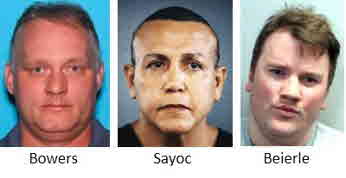 James isn’t the only social media addict to act on his worst impulses. “Preventing Mass Murder” focused on three once-nobodies who left their despicable marks in 2018: James isn’t the only social media addict to act on his worst impulses. “Preventing Mass Murder” focused on three once-nobodies who left their despicable marks in 2018:
- Robert Bowers, a middle-aged recluse, used an AR-15 rifle and three pistols to kill eleven and wound six, including four police officers, at Pittsburgh’s “Tree of Life” synagogue. An “isolated, awkward man who lived alone and struggled with basic human interactions,” Bowers frequently posted comments disparaging Jewish persons on Gab, an alternative online platform that reportedly remains popular with extremists.
- Cesar Sayoc, a middle-aged bodybuilder with an extensive criminal record for property and violent crime, mailed thirteen explosives-laden packages to politicians and past and present Government officials. With his personal life long in the dumps, Sayoc apparently felt he had nothing to lose, and he used Facebook and Twitter to rant at his intended victims. California Congresswoman Maxine Waters got a tweet that read “see you soon.” Former Attorney General Eric Holder, Jr. received a similar message, appended with “tick tock.”
- But the third middle-aged guy, Scott Beierle, was different. (We say “was” because he killed himself.) His “thing,” though, wasn’t politics – it was that women paid him no heed. His YouTube posts glorified “Incel” (involuntary celibacy) and praised the movement’s former head, sometime Santa Barbara college student Elliot Rodger. We say “former” because Rodger, who knifed and shot six students dead and injured a dozen others during his vengeful spree in 2014, also killed himself. At the ripe old age of twenty-two.
And the carnage continued. In April 2019 John Earnest, 19, posted a vitriolic, anti-Semitic rant on “8chan” (now “8kun”), a message board described as a “megaphone for mass shooters.” He then stormed into a San Diego-area synagogue and opened fire, killing one and wounding three. Four months later Patrick Crusius, a 21-year old Texas man, posted a hateful anti-Mexican, anti-immigrant diatribe on 8chan. Wielding an AK-style rifle, he went on a shooting spree at an El Paso Walmart, killing twenty-three and wounding an equal number. It’s thought that Crusius, who “spent countless hours on the Internet” following white supremacy, essentially learned to hate online.
Alas, despite gun laws and physical security measures (the Poway massacre led President Trump to suggest posting armed guards at religious services) mass killings persist. But is it possible to act before twisted killers strike? Absolutely, says the FBI. Consider, for example, the case of Robert Hester, whose online posts glorifying ISIS and justifying violence drew the attention of undercover agents. Ultimately roped in to an FBI-fabricated scheme to stage “a mass casualty attack,” Hester pled guilty in 2019 to attempting to provide material support to a terrorist organization. He got twenty years.
 There have been dozens of such cases. Yet our posts (see, for example, “Written, Produced and Directed”) have persistently voiced skepticism about the viability of the threats. Lacking an undercover agent’s friendly “guidance,” many wannabees seemed unlikely to act on their own. Prediction, though, is a tricky business (see, for example, “Missed Signals”). Consider the flack the FBI got for supposedly overlooking the many social media posts that warned about a forthcoming Capitol assault. In “Chaos in D.C.” we mentioned that the phrase “storm the Capitol” came up online 100,000 times during the preceding month. There have been dozens of such cases. Yet our posts (see, for example, “Written, Produced and Directed”) have persistently voiced skepticism about the viability of the threats. Lacking an undercover agent’s friendly “guidance,” many wannabees seemed unlikely to act on their own. Prediction, though, is a tricky business (see, for example, “Missed Signals”). Consider the flack the FBI got for supposedly overlooking the many social media posts that warned about a forthcoming Capitol assault. In “Chaos in D.C.” we mentioned that the phrase “storm the Capitol” came up online 100,000 times during the preceding month.
According to NBC News, part of the FBI’s hesitancy to investigate the Capitol plotters may have been that a massive online “dig” for incriminating information could harken back to the scandalous “snooping” of the Hoover years. Another roadblock – the sheer mass of the content, and how to separate the wheat from the chaff – was mentioned by FBI Director Christopher Wray during his testimony to the Homeland Security Committee as it investigated the lack of preparedness for the assault:
And how to separate who’s being aspirational versus who’s being intentional, it won’t shock you to learn, and hopefully not other members of the committee, that the amount of angry, hateful, unspeakable, combative, violent, even rhetoric, on social media exceeds what anybody in their worst imagination is out there. And so trying to figure out who’s just saying, “You know what we ought to do is X.” Or, “Everybody ought to do X.” Versus the person who’s doing that, and actually getting traction, and then getting followers, and of course, that’s assuming that they’re not communicating through encrypted channels about all that stuff, is one of the hardest things there is to do in today’s world with the nature of the viral extremism threat we face.
As he agonized about making sense of the disjointed chatter, Director Wray was alluding to a key issue. Unlike the wannabe terrorists that his agents occasionally snared, the Capitol plotters didn’t clearly appropriate the language of crime. Protesting, after all, is a Constitutional right. Given the chaotic online scene, gathering compelling evidence that specific persons will seek regime change through lawbreaking is no simple task. These “dopes” didn’t set themselves up to be “roped.”
It’s not just about the Capitol assault. Consider subway shooter Frank R. James. He ranted extensively, and over a long period. Yet as far as we know, his first allusion to shooting anyone came only one day before his attack. And even then, no specific targets were announced. Bowers, Sayoc and Beierle also posted profusely. But only Sayoc delivered individualized threats, and these came very late in the process. Similar obstacles would have beset anyone examining the online trails left by John Earnest and Patrick Crusius. To be sure, both seemed potentially dangerous. But building a criminal case takes a whole lot more.
Set “criminal case” aside. Restraining orders are often granted after episodes of domestic violence. In some places their use has expanded to include persons whom family members and police deem untrustworthy with a gun (see “Red Flag” I and II.) There are also many provisions for dealing with the mentally ill (see “A Stitch in Time”). But massacres are something new. The threat they pose to educational institutions has led many school districts to adopt the “threat assessment” approach. Developed in the nineties, it’s a comprehensive process for identifying possible perpetrators, evaluating their risks, and moving them away from violence through counseling, social services and other supports (for a new book about the technique click here.)
Threat assessment relies on referrals from police officers, family members and friends. Could it be expanded to encompass the online world? Perhaps. But as FBI Director Wray testified, given the massive nature of online chatter, distinguishing between the “aspirational” and the “intentional” would require special tools and dedicated analysts:
So there’s a data analytics piece, because the volume is so significant that we need to get better at being able to analyze the data that we have to do it in a timely way, to separate the wheat from the chaff. And that requires both tools, analytical tools, and we’ve had requests for those in the budgets the last couple of years, but also people, data analysts, who can devote their time to that who have the experience.
Be sure to check out our homepage and sign up for our newsletter
 According to an article in the October 2018 NIJ Journal, “Using Artificial Intelligence to Address Criminal Justice Needs,” A.I. could help. Although the emphasis is clearly on other things, a section about crime forecasting mentions that A.I. could scan media to “identify criminal enterprises” and “predict and reveal people at risk.” According to an article in the October 2018 NIJ Journal, “Using Artificial Intelligence to Address Criminal Justice Needs,” A.I. could help. Although the emphasis is clearly on other things, a section about crime forecasting mentions that A.I. could scan media to “identify criminal enterprises” and “predict and reveal people at risk.”
We thought the approach intriguing. It seemed especially applicable to our three killers of note, Bowers, Sayoc and Beierle, as each had an expansive, long-standing online presence. Yet as the Brennan Center recently cautioned, Government monitoring of social media platforms raises a host of civil liberties issues. Participants at a 2o19 NAS symposium on human rights worried that AI’s use by the authorities could worsen bias and inequality. Such concerns likely drove Senator Ben Sasse to spill his drink on Director Wray’s great notion:
I would love to hear your big national pitch for these data analysts because we need more great human capital to serve their country in this way. But I also want to be sure that our training for these data analysts have First Amendment sensibilities about what they’re there to do. They’re looking for violence, they’re not looking there to be the national speech police.
Actually, the good Senator need not worry. At present, the “craft of policing” isn’t about trolling for lunatics, online or otherwise. As your writer can personally attest, law enforcement agencies – including the FBI – have always focused on crimes, investigations and arrests. That’s what their budgets are built on. It’s how their employees earn promotions and advance through the ranks. So while our epidemic of mass shootings and the Capitol assault may have caused some reconsideration, America’s law enforcement agencies remain firmly planted in the offline world. As long as wackos and killers don’t accidentally cozy up to an undercover Fed, they can likely keep using the Internet to their twisted hearts’ delight.
UPDATES (scroll)
5/19/25 A Palm Springs, Calif. reproductive clinic that advertises its services to the LGBTQ+ community was leveled by an explosion. The blast, which also damaged nearby buildings, was caused by a homebuilt bomb detonated by Guy Edwards Bartkus, a 25-year old resident of a high-desert community an hour’s drive away. Bartkus posted extensive rants on social media calling for “a war against pro-lifers” and threatening to attack a fertilization clinic. He brought the bomb and two assault-style rifles in his car and died in the blast. Four persons were injured, none severely.
4/23/25 An unforgettable image depicts the widow of a man whom Patrick Crusius murdered during the 2019 Walmart massacre hugging the killer in a Texas courtroom. Adriana Zandri was one of several relatives of Crusius’ twenty-three victims who accepted the opportunity to interact with the shackled gunman at his plea hearing. “Pain and devastation” aside, several said they had no option but to forgive and move on.
4/22/25 “You came to inflict terror, to take innocent lives, and to shatter a community that had done nothing but stand for kindness, unity and love. You slaughtered fathers, mothers, sons and daughters...” With these words Texas State Judge Sam Medrano accepted the guilty plea of Patrick Crusius to the August 2019 murder of twenty-three persons at an El Paso Walmart. Crusius, who is already serving multiple life terms in Federal prison, will automatically draw life without parole. He pled guilty after prosecutors, who wished to ease the burden on survivor families, offered to forego the death penalty.
Keep going...
|
Did you enjoy this post? Be sure to explore the homepage and topical index!
Home Top Permalink Print/Save Feedback
RELATED POSTS
Gun Massacres special topic
Are We Helpless to Prevent Massacres? Another Day, Another Massacre Chaos in D.C.
Preventing Mass Murder Ban the Damned Things! Red Flag (I) (II) Massacre Control
A Stitch in Time After the Fact Coming Clean in Santa Barbara Written, Produced and Directed
Flying Under the Radar Taking Bombs From Strangers Missed Signals
|